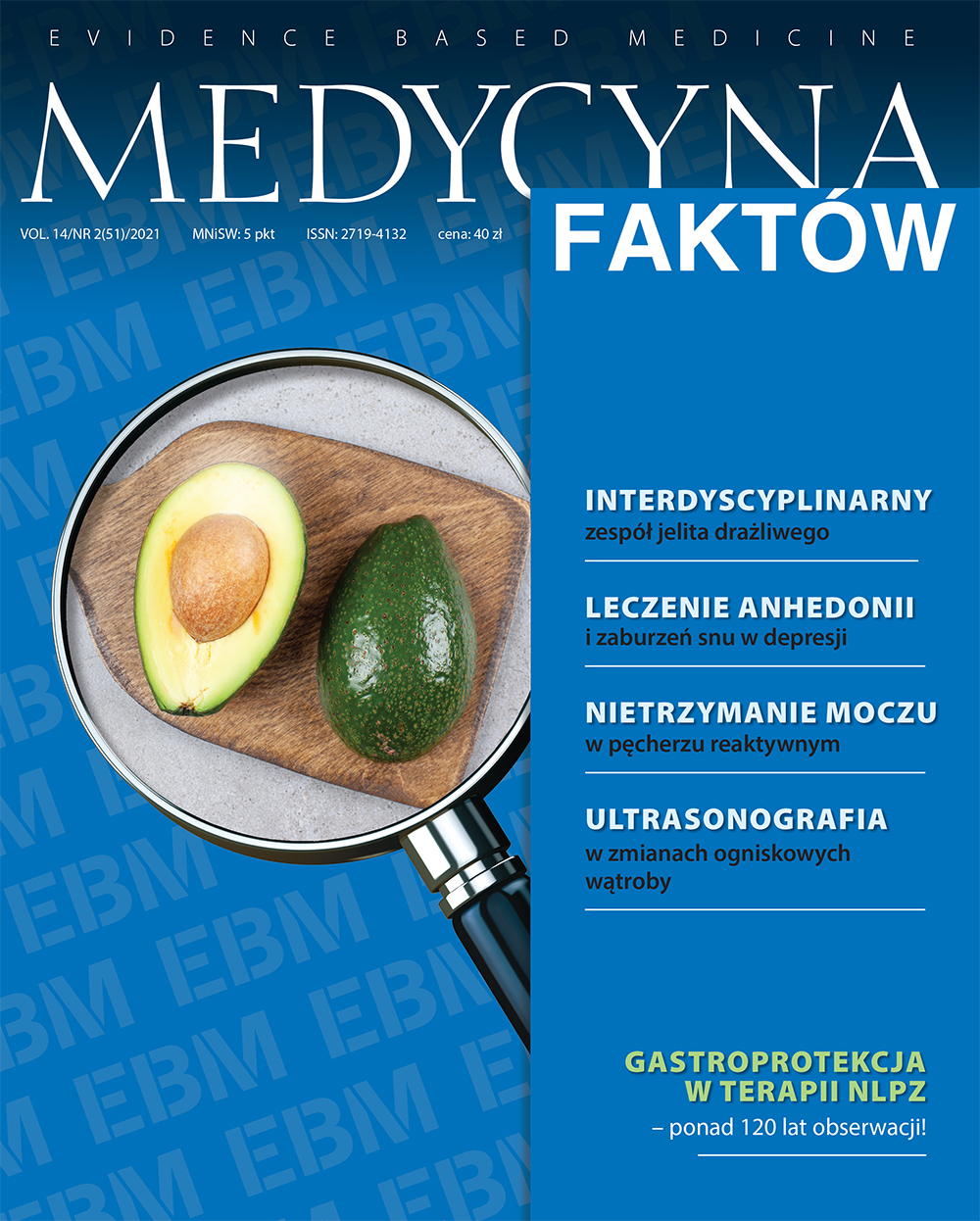The use of agomelatine in the reduction of anhedonia and sleep disorders in the course of depression Review article
Main Article Content
Abstract
Agomelatine is an antidepressant with a unique pharmacological profile, it acting as an agonist of MT1 and MT2 melatoninergic receptors and as an antagonist of the 5-HT2C receptor. The drug has a quick onset of action and a long maintenance of the therapeutic effect, also it is well tolerated. In clinical studies in patients with depression agomelatine reduces anxiety symptoms and improves sleep quality, not causing sedation, weight gain, sexual dysfunction or suppression of emotional responses.
Article Details
How to Cite
Antosik-Wójcińska, A. (2021). The use of agomelatine in the reduction of anhedonia and sleep disorders in the course of depression. Medycyna Faktow (J EBM), 14(2(51), 178-181. https://doi.org/10.24292/01.MF.0221.6
Issue
Section
Articles
Copyright © by Medical Education. All rights reserved.
References
1. Stahl SM. Mechanism of action of agomelatine: a novel antidepressant exploiting synergy between monoaminergic and melatonergic properties. CNS Spectr. 2014; 19(3): 207-12.
2. Racagni G, Riva MA, Molteni R et al. Mode of action of agomelatine: synergy between melatonergic and 5-HT2C receptors. World J Biol Psychiatry. 2011; 12: 574-87.
3. Landowski J. Agomelatyna – oryginalny lek przeciwdepresyjny. Psychiatria. 2012; 9(1): 11-20.
4. Racagni G, Popoli M. The pharmacological properties of antidepressants. Int Clin Psychopharmacol. 2010; 25: 117-31.
5. Vinckier F, Gourion D, Mouchabac S. Anhedonia predicts poor psychosocial functioning: results from a large cohort of patients treated for major depressive disorder by general practitioners. Eur Psychiatry. 2017; 44: 1-8.
6. Zimmerman M, McGlinchey JB, Posternak MA et al. Discordance between self-reported symptom severity and psychosocial functioning ratings in depressed outpatients: Implications for how remission from depression should be defined. Psychiatry Res. 2006; 141(2): 185-91.
7. Wichniak A, Szmyd J. Leczenie depresji poprzez normalizację zaburzonego rytmu snu i czuwania. Psychiatr Psychol Klin. 2019; 19(3): 338-43.
8. de Bodinat C, Guardiola-Lemaitre B, Mocaër E et al. Agomelatine, the first melatonergic antidepressant: discovery, characterization and development. Nat Rev Drug Discov. 2010; 9: 628-42.
9. Serretti A, Mandelli L. Antidepressants and body weight: a comprehensive review and meta-analysis. J Clin Psychiatry. 2010; 71: 1259-72.
10. Taylor D, Sparshat A, Varma S et al. Antidepressant efficacy of agomelatine: meta-analysis of published and unpublished studiem. BMJ. 2014; 348: 1888.
11. Demyttenaere K, Corruble E, Hale A et al. A pooled analysis of six month comparative efficacy and tolerability in four randomized clinical trials: agomelatine versus escitalopram, fluoxetine, and sertraline. CNS Spectr. 2013; 18: 163-70.
12. Khoo AL, Zhou HJ, Teng M et al. Network meta-analysis and costeffectiveness analysis of new generation antidepressants. CNS Drugs. 2015; 29: 695-712.
13. Laux G, Barthel B, Hajak G et al. Pooled analysis of four non-interventional studies: effectiveness and tolerability of the antidepressant agomelatine in daily practice. Adv Ther. 2017; 34: 895-914.
2. Racagni G, Riva MA, Molteni R et al. Mode of action of agomelatine: synergy between melatonergic and 5-HT2C receptors. World J Biol Psychiatry. 2011; 12: 574-87.
3. Landowski J. Agomelatyna – oryginalny lek przeciwdepresyjny. Psychiatria. 2012; 9(1): 11-20.
4. Racagni G, Popoli M. The pharmacological properties of antidepressants. Int Clin Psychopharmacol. 2010; 25: 117-31.
5. Vinckier F, Gourion D, Mouchabac S. Anhedonia predicts poor psychosocial functioning: results from a large cohort of patients treated for major depressive disorder by general practitioners. Eur Psychiatry. 2017; 44: 1-8.
6. Zimmerman M, McGlinchey JB, Posternak MA et al. Discordance between self-reported symptom severity and psychosocial functioning ratings in depressed outpatients: Implications for how remission from depression should be defined. Psychiatry Res. 2006; 141(2): 185-91.
7. Wichniak A, Szmyd J. Leczenie depresji poprzez normalizację zaburzonego rytmu snu i czuwania. Psychiatr Psychol Klin. 2019; 19(3): 338-43.
8. de Bodinat C, Guardiola-Lemaitre B, Mocaër E et al. Agomelatine, the first melatonergic antidepressant: discovery, characterization and development. Nat Rev Drug Discov. 2010; 9: 628-42.
9. Serretti A, Mandelli L. Antidepressants and body weight: a comprehensive review and meta-analysis. J Clin Psychiatry. 2010; 71: 1259-72.
10. Taylor D, Sparshat A, Varma S et al. Antidepressant efficacy of agomelatine: meta-analysis of published and unpublished studiem. BMJ. 2014; 348: 1888.
11. Demyttenaere K, Corruble E, Hale A et al. A pooled analysis of six month comparative efficacy and tolerability in four randomized clinical trials: agomelatine versus escitalopram, fluoxetine, and sertraline. CNS Spectr. 2013; 18: 163-70.
12. Khoo AL, Zhou HJ, Teng M et al. Network meta-analysis and costeffectiveness analysis of new generation antidepressants. CNS Drugs. 2015; 29: 695-712.
13. Laux G, Barthel B, Hajak G et al. Pooled analysis of four non-interventional studies: effectiveness and tolerability of the antidepressant agomelatine in daily practice. Adv Ther. 2017; 34: 895-914.

